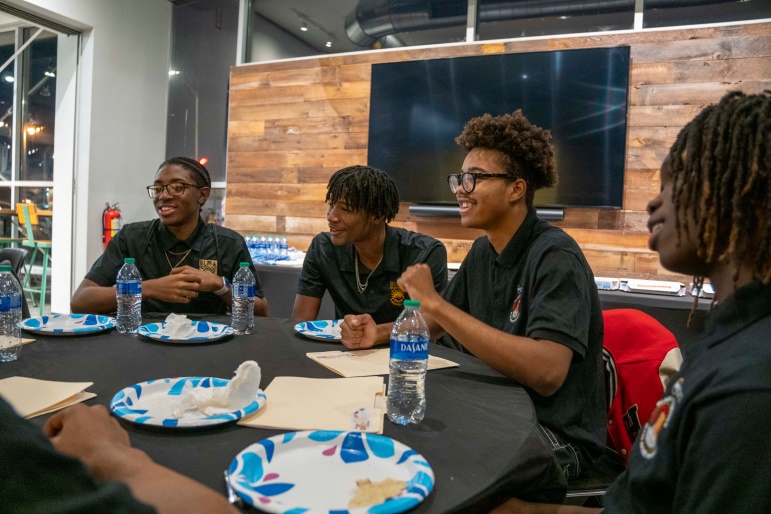After Missteps, Milwaukee Launching New Effort To Help Young Black Men
Lack of resources, infighting doomed prior efforts. Walter Lanier is charting a new course.

Milwaukee Public Schools students attend a community conversation with Milwaukee Bucks basketball player Cameron Payne at the American Black Holocaust Museum in Milwaukee. The conversation was part of a mentoring program through the school district’s Department of Black and Latino Male Achievement. (Courtesy of Milwaukee Public Schools)
This story was originally published by Wisconsin Watch.
Walter Lanier stood before a packed room at the Milwaukee County Zoo in May and repeated his mantra: “We have to be organized.”
The room was filled with Black leaders — mostly men — from government, nonprofits and academic institutions. The leaders knew all too well that, year after year, studies have ranked the Milwaukee metropolitan area the worst place to live if you’re Black.
But Lanier, a pastor and community leader who also has worn the hats of educator and lawyer, announced plans to change the narrative by changing the reality — particularly for Black men.
Since 2022, Lanier has served as president and CEO of the African American Leadership Alliance Milwaukee. The nonprofit aims to make Milwaukee a top city for Black residents by 2025 and serves as the backbone for its latest push to narrow wide achievement gaps for Black men and boys.
Doing so, Lanier told the gathering, would require all-hands-on-deck cooperation among nonprofits, civic groups and government.
“All over the city and all over the county, we have all types of stuff going on,” Lanier said. “We haven’t been as organized and connected as we need to be.”
It’s hardly Milwaukee’s first effort to boost the achievement of Black boys and men.
Responding to a nationwide challenge by then-President Barack Obama, city leaders a decade ago launched an initiative to “address the multitude of challenges” that disadvantage Black men and boys in Milwaukee. That initiative sparked the creation of a Black Male Achievement Advisory Council to set a policy agenda, provide a funding apparatus and coordinate groups striving toward similar goals.
But the initiative fizzled without measurable results, and the council stopped meeting in 2021 — during a mayoral transition and a COVID-19 pandemic that disproportionately harmed Black residents.
Some suggest the effort fell victim to a culture in Milwaukee where ideas often languish without public commitment and coordination. But city leaders are optimistic a new effort under new leadership will yield progress.

Walter Lanier, president and CEO of the nonprofit African American Leadership Alliance of Milwaukee, is seen in his office in Milwaukee on June 26, 2023. The nonprofit aims to make Milwaukee a top city for Black residents by 2025, and it serves as the backbone for the city’s latest push to narrow wide achievement gaps for Black men and boys. (Jonmaesha Beltran / Wisconsin Watch)
Already Lanier’s group has helped Milwaukee gain certification within the Obama Foundation’s My Brother’s Keeper Alliance network, allowing leaders to learn from other communities seeking to improve the lives of men of color.
“Things are changing,” Milwaukee County Executive David Crowley told Wisconsin Watch. “How do we have diversity of thought, diversity of people to really help us move the needle when it comes down to eliminating the racial disparities and the health disparities that we see in Milwaukee County?”
Black Male Achievement Advisory Council
Milwaukee has sought to address barriers for Black males since the 1980s, by which point all of the region’s job growth had shifted to the suburbs.
First came the Milwaukee African American Male Task Force, which led to the creation of African American immersion schools. Then the Milwaukee Parental School Choice Program, which provides funding for children to attend private school. Later was the Milwaukee Fatherhood Collaborative, which advocated for fathers’ rights and for more involvement with their children. The Milwaukee African American Male Unemployment Task Force was among other groups to come.
But the Black Male Achievement Advisory Council, created by a 2013 city ordinance, promised to be different.
Joe Davis Sr., a Common Council member at the time, spearheaded the plan to bring all such efforts under one umbrella to recommend policies and track progress through measurable data.
Following decades of “stealth depression,” Milwaukee was among the top 10 poorest U.S. cities, with 38% of its Black population living below the poverty level and deep disparities between Black and white males.
Only 3% of Black male eighth graders at the time read at or above grade level, 45% graduated on time from high school, and firearm homicide was the leading cause of death for ages 11 to 39 years old.

Black men and boys lock arms at a rally in Milwaukee’s Sherman Park neighborhood on Sept. 10, 2016. The rally was organized by the 300+ Strong coalition, which includes Black-led organizations serving Milwaukee youth. The coalition was created in conjunction with the national My Brother’s Keeper initiative and the Milwaukee Black Male Achievement Advisory Council. (Jabril Faraj / Milwaukee Neighborhood News Service)
The National League of Cities, which supports local governments, agreed to assist Milwaukee with data tracking and coaching to reduce racial disparities in education, work and family outcomes.
Business, philanthropic and faith-based leaders joined city, school and police officials in monthly meetings of the Black Male Achievement Advisory Council.
“I cannot recall a time in the city where there was as much energy and cohesiveness across political lines — across business and municipal government, philanthropy partners all speaking and agreeing about a pathway forward — to address this issue,” former Common Council member Ashanti Hamilton told Wisconsin Watch.
But tension arose between Davis and then-Mayor Tom Barrett, the council’s co-chairs, before the council reached its first anniversary.
After the city allocated an additional $300,000 in federal Community Development Block Grant dollars to support the council’s goals, Davis called for a larger investment.
“Unfortunately, what I’m finding is that the mayor is not interested in taking a risk or claiming this particular issue on behalf of Black men and boys,” Davis said during a 2014 Common Council meeting.
The frustrations prompted Davis to resign as council co-chair that year. Speaking to Wisconsin Watch, he called Barrett “an obstructionist” who didn’t want to offend other residents by addressing challenges for Black males.
Barrett, now a U.S. ambassador to Luxembourg, did not respond to interview requests for this story.
Obama issues My Brother’s Keeper challenge
But in 2015 the council saw an opportunity in Obama’s My Brother’s Keeper initiative, launched two years after the Florida killing of 17-year-old Trayvon Martin reignited national discussions about the life-and-death barriers Black males face.
Obama challenged local officials to build “My Brother’s Keepers Communities” by ensuring Black boys enter school ready to learn, read at grade level by third grade, graduate from high school, complete postsecondary education or training and remain safe from violent crime.
Milwaukee officials joined nearly 200 mayors, tribal leaders and county executives across 43 states and the District of Columbia who have accepted the challenge.
In 2015 Barrett and Hamilton, who succeeded Davis as Black Male Achievement Advisory Council co-chair, created a five-year plan focused on 10 priorities for males of color:
- Increase high school graduation rates and readiness for college and/or the workplace.
- Increase rates of graduation from post-secondary education or job training.
- Increase rates of employee retention and promotion.
- Make workplaces attractive and accessible.
- Improve the administration of justice.
- Increase capacity to combat violence and victimization.
- Protect physical, emotional, mental and spiritual wellness.
- Fuel creativity and entrepreneurship.
- Establish alternative community-based institutions to sustain achievement.
- Increase representation and participation in decision-making bodies and processes across all sectors.
The city laid out a variety of more specific goals in the plan, ranging from increasing graduation rates for students of color by at least 0.5% annually to boosting Black male voter registration rates by at least 3% annually.

Students from seven Milwaukee public schools attend a special viewing of “Black Panther” and reflection session at the Marcus North Shore Cinema in Mequon, Wis., in March 2018. Officials with the Milwaukee Public Schools Department of Black and Latino Male Achievement, which partnered on the event with Ald. Khalif Rainey, discussed the importance of the students being able to see a positive narrative about Black men, created mostly by Black directors and actors. (Courtesy of Milwaukee Public Schools)
While Hamilton cautioned against becoming frozen in a “search for perfection,” some council members worried about a lack of measurable metrics attached to several items. The Black Male Achievement Advisory Council allocated $50,000 to the Center for Self-Sufficiency to evaluate the plan’s metrics.
Carl Wesley, the center’s president and CEO at the time, told Wisconsin Watch he ran into brick walls while trying to collect baseline data from various entities relevant to the council’s efforts, and many of the plan’s goals were vague.
“It had things in there, like increase from this to that, but no one knew where they were to increase from,” he said.
In 2018 the city joined Milwaukee Public Schools, Employ Milwaukee and the local United Way chapter in seeking funding from the My Brother’s Keeper Community Challenge competition, which required an action plan and a protocol for tracking data and benchmarks.
The application did not draw funding. My Brother’s Keeper instead named Milwaukee a “Community to Watch.”
Local officials at the time acknowledged Milwaukee’s lack of progress on improving outcomes for Black males. While the city saw increased engagement around such issues, it didn’t translate into lower crime rates or higher graduation rates.
“Many grassroots and nonprofit organizations make claim to a number of programs and initiatives that support Black men and boys, but operate in silos with inadequate resources and no unifying measures to reinforce efforts between them to collectively move the needle on outcomes,” Jeff Roman, a consultant who later directed the Milwaukee County Office of Equity, wrote in a 2018 report. “Where substantial investments are being made, little information exists on actual impacts, and the information that does exist suggests that little improvement is being made.”
The national Campaign for Black Male Achievement network in 2018 cited a “strong city administration commitment to Black men and boys,” while showing a need for more targeted funding and better participation and coordination among government, nonprofits and other groups invested in Black male achievement.
The city’s Black Male Achievement Advisory Council stopped meeting in 2021 as Cavalier Johnson replaced Barrett as mayor and COVID-19 disrupted life.
“There was no individual person to pick it up and keep it moving,” Hamilton said, calling for leaders to make long-term commitments to things they say they care about.

Milwaukee Public Schools students attend a financial literacy session with Milwaukee Bucks basketball player Khris Middleton at the Fiserv Forum in Milwaukee — part of a mentoring session organized by the school district’s Department of Black and Latino Male Achievement, which provides mentorship and opportunities to 500 Black and Latino male students. (Courtesy of Milwaukee Public Schools Department of Black and Latino Male Achievement.)
Depending on municipal government to oversee initiatives carries risks, said Shawn Dove, former CEO of the Campaign for Black Male Achievement, which worked with Milwaukee leaders. Political leaders often change, as do their commitments. Housing an initiative outside of government — but still inviting municipal leaders to participate — can bring more stability, he said.
Whether Johnson will revive the council remains unclear. His office did not respond to Wisconsin Watch’s repeated requests for an interview. Nor did José Pérez, the Common Council president.
Nate Deans, the director of Milwaukee Public Schools’ Department of Black and Latino Male Achievement, hopes the council resumes.
The creation of his department, which provides mentors to 500 Black and Latino male students, resulted from the council’s recommendations.
“It’ll streamline the work that much more if we’re all at least meeting,” Deans said.
Christopher Walton Jr., who briefly served on the council before it stopped meeting, said restarting meetings could help.
“It’s a disservice to the community and to young Black males that we don’t have people putting their hand back on that to get that moving again,” he said. “And so I would definitely love to see that brought back up in full force and get moving again.”
‘Community to watch’ to certified city
Regardless, Lanier and the African American Leadership Alliance are forging ahead. He didn’t want Milwaukee’s My Brother’s Keeper plan to go to waste.
He called it a well-designed plan that was insufficiently resourced.
Lanier said he’s forming partnerships to strengthen the plan, with a focus on education, employment and anti-violence.
“We’re doing work in all of those areas in Milwaukee, but it’s segregated and fragmented and siloed,” Lanier said. “As a result, we don’t present as well as we could externally.”
They include cities like Newark, New Jersey, and Omaha, Nebraska. Newark’s homicides plunged by 55% from 2013 to 2021, and Omaha’s homicides dropped by 30% from 2011 to 2022 due to cross-community collaboration, according to the My Brother’s Keeper Alliance. In Tulsa, Oklahoma, enrollment for students of color in pre-kindergarten increased by 33% from 2013 to 2019, and in Yonkers, the city now has New York’s highest graduation rate for students of color: 91%, according to the alliance.
Lanier hopes My Brother’s Keeper will ultimately certify the state as well. That’s the case in Ohio, where researchers at The Ohio State University and community members partner on best practices for boosting Black male achievement.
Marquette University’s Center for Urban Research, Teaching, and Outreach is helping Lanier identify metrics and compile data to populate a citywide dashboard to track the progress of Black male achievement. The center, which has worked with Lanier for several years, has identified dozens of local organizations and institutions working on equity issues.
Lanier envisions a future Milwaukee where Black people thrive. That will require making measurable progress and changing narratives in Milwaukee.
“Because if we open that door for us, just like everything else, that door is open for everybody else,” Lanier said at the May gathering. “It’s my job to get it done.”
Learn more
Those wanting to learn more about the African American Leadership Alliance’s collaboration to improve Black male achievement in Milwaukee can sign up for updates at this link.
Editor’s note: Bevin Christie, project manager for Wisconsin Watch’s News414 service journalism collaboration with Milwaukee Neighborhood News Service, has worked as a consultant with the African American Leadership Alliance of Milwaukee.
The nonprofit Wisconsin Watch (www.WisconsinWatch.org) collaborates with Milwaukee Neighborhood News Service, WPR, PBS Wisconsin, other news media and the University of Wisconsin-Madison School of Journalism and Mass Communication. All works created, published, posted or disseminated by Wisconsin Watch do not necessarily reflect the views or opinions of UW-Madison or any of its affiliates.
Political Contributions Tracker
Displaying political contributions between people mentioned in this story. Learn more.
- January 29, 2016 - David Crowley received $25 from Walter Lanier
- August 13, 2015 - Cavalier Johnson received $25 from David Crowley
- May 5, 2015 - José G. Pérez received $10 from Cavalier Johnson




















